Corsair Carbide 200R Case Review: How Low Can You Go
by Dustin Sklavos on December 15, 2012 12:01 AM EST- Posted in
- Cases/Cooling/PSUs
- Corsair
- mid-tower
Noise and Thermal Testing, Overclocked
The limited cooling capabilities of a budget case keep our expectations in check, but it's important to keep in mind that historically enthusiasts were about getting the most bang for their buck they could (essentially the purpose behind overclocking in the past). By that token, it's important to see if the Corsair Carbide 200R leaves your system any room to stretch its legs. Theoretically an end user should be able to take an inexpensive unlocked Vishera or Trinity CPU and motherboard, a solid budget cooler like one of Cooler Master's Hyper 212s, and get a healthy amount of performance for their dollar.
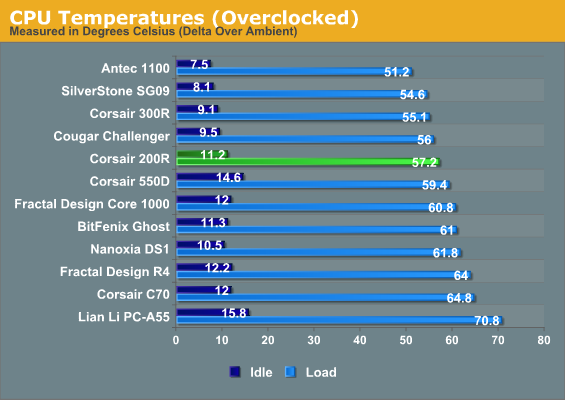
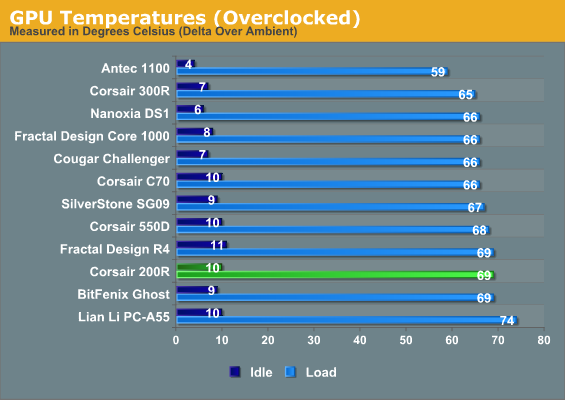

You're not liable to get much extra latitude out of your video card in the Carbide 200R, and SSD temperatures continue to be incredibly problematic, but you can definitely score some additional mileage out of your CPU. The Carbide 200R's CPU performance isn't stellar, but it's strong enough.
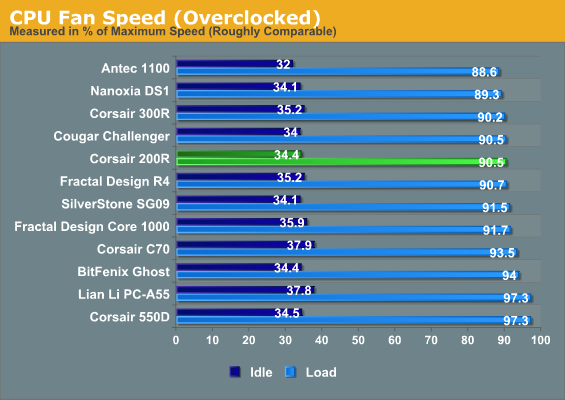
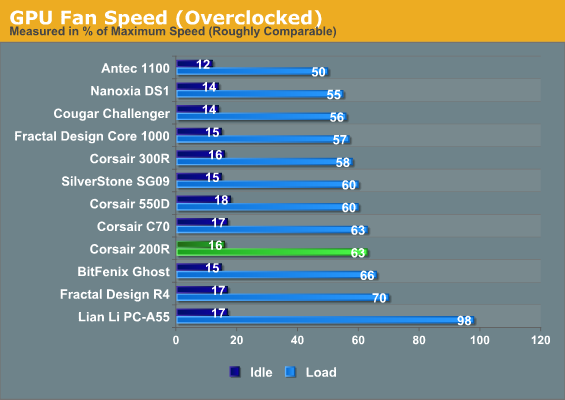
Fan speeds aren't ideal, but they're at least still on the lower end of competitive.
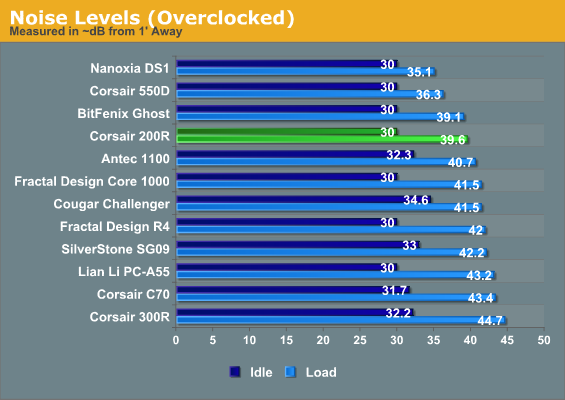
Noise levels also aren't particularly good, but they're not awful, either. Nobody's going to accuse the Carbide 200R of being a quiet enclosure. That's not what it's designed for, though, so we can let a little bit of noise slide.










25 Comments
View All Comments
Torrijos - Saturday, December 15, 2012 - link
I'm left wondering what is the useful effect of each fan in cooling the machine.It might be interesting to have a guide analysing the effect of some fans combinations on the cooling performances.
As an example of the question that need answering:
- As it been determined which is preferable, positive or negative pressure?
- Should a top radiator be use as an intake port (thus improving the CPU cooling by using fresh air, and with a fan pushing air does it improve the fan efficiency since its pushing colder/denser air trough?), or as an exhaust (avoiding hot air build up in the case)?
- Should fans be use to push or pull air through a radiator?
jonjonjonj - Saturday, December 15, 2012 - link
i think your looking for this. they are interesting articles.http://www.tomshardware.com/reviews/cooling-airflo...
http://www.tomshardware.com/reviews/cooling-air-pr...
billcat1447 - Sunday, December 16, 2012 - link
I played with different fans acting on the internal pressure and found you def. want more air coming in than going out which I guess would be pos. pressure.The case didn't have the vent holes that most modern cases have so when I had more pressure pumping air out than in it caused the fans to work very hard to remove the air from inside the case and worst case it also overheated the power supply because it could not move air though it and pump it outside the case. I almost destroyed the power supply, the air was super hot. With air holes in modern cases and if it was all run through filters it might case the same condition but not as bad. You want dust to be removed before it can enter inside components so I would guess if filtered the less air being added would be the way to go. Most cases don't filter all the holes and I would want more air removed from the case than fans pulling air into the case but I would really only care about which fans can remove dust and mount then that way and which ones will cool the best while not adding dust and bringing air into the case. If there is a lot of holes pos or neg doesn't matter but the way the fans are mounted to get the best out of them is the most important part. I'd have air removed from the top fans, air removed from the power supply. Air entered for the front hard drive cooling fans and air entered from the side fan cooling the motherboard and memory (only if it's filtered).
Tech-Curious - Saturday, December 15, 2012 - link
There are endless debates about positive versus negative pressure. Different manufacturers even seem to have different opinions on the subject. (Antec, for example, seems to endorse negative pressure by default, whereas Silverstone is a vocal advocate of positive pressure.) Purely as a matter of cooling efficiency, I don't think there's a right answer: the ideal solution depends as much on the fans' placement in relation to your hardware as it depends on the direction of their airflow.That said, and all else being equal, I will always favor (filtered) positive air pressure, just because it reduces (or practically eliminates, in some cases) dust build up, and thus it saves the user from having to clean out the inside of his case regularly.
HisDivineOrder - Saturday, December 15, 2012 - link
Imagine an Obsidian 150D for premium ITX.jonjonjonj - Saturday, December 15, 2012 - link
i like the look. im not into the alien abducted my computer look. im convinced i could design a better budget case then most of these companies. if im going to buy a case that costs under $50 all im expecting is good cable management and air flow. i wonder what this case costs corsair air to make.Donniesito - Sunday, December 16, 2012 - link
Agreed. Give me clean lines, and I'm happy. I'm of the opinion that since my computer sits next to my desk on the floor, it doesn't matter what it looks like. It needs to be unobtrusive, and doesn't need to look like an alien ate my computer, nor does it need to light up like a runway. It just needs to sit there and work.. My display on the other hand needs to be all sorts of awesome ;-)johan851 - Sunday, December 16, 2012 - link
I felt like that little dig at the end of the article was neither relevant or correct. Thinkpads are still great, and what's that got to do with cases?JonnyDough - Sunday, December 16, 2012 - link
One Thing I would have liked to see:Completed cable management. Show me a finished computer with the cables all ziplocked down and looking clean. I just bought a Thermaltake Chaser MK-1 and did this and it's the best build I've done over the years. It really makes the PC look nice. Sufficient space behind the motherboard makes a huge difference, as do the pass through holes for the cables.
Donniesito - Sunday, December 16, 2012 - link
I agree with this also. However, I don't use zip-ties for cable management. Years ago I learned the awesomeness that are velcro zip-ties and I've never looked back ;-)